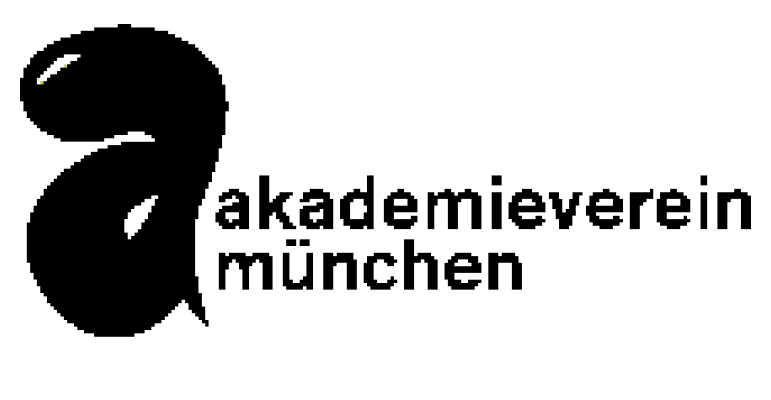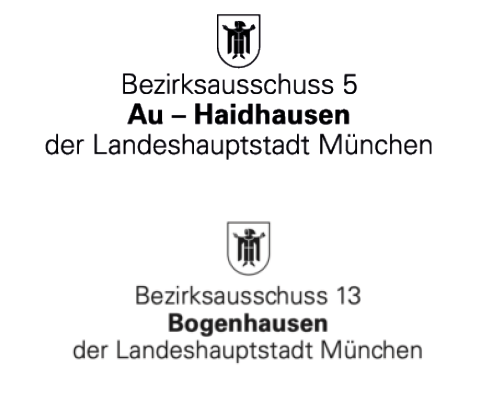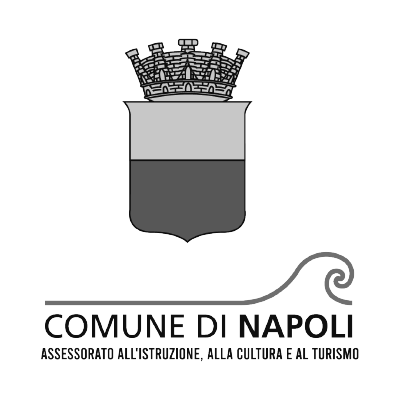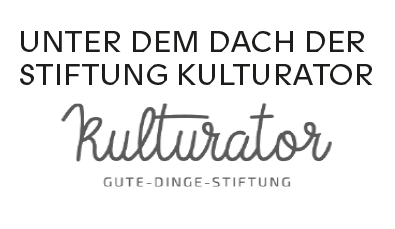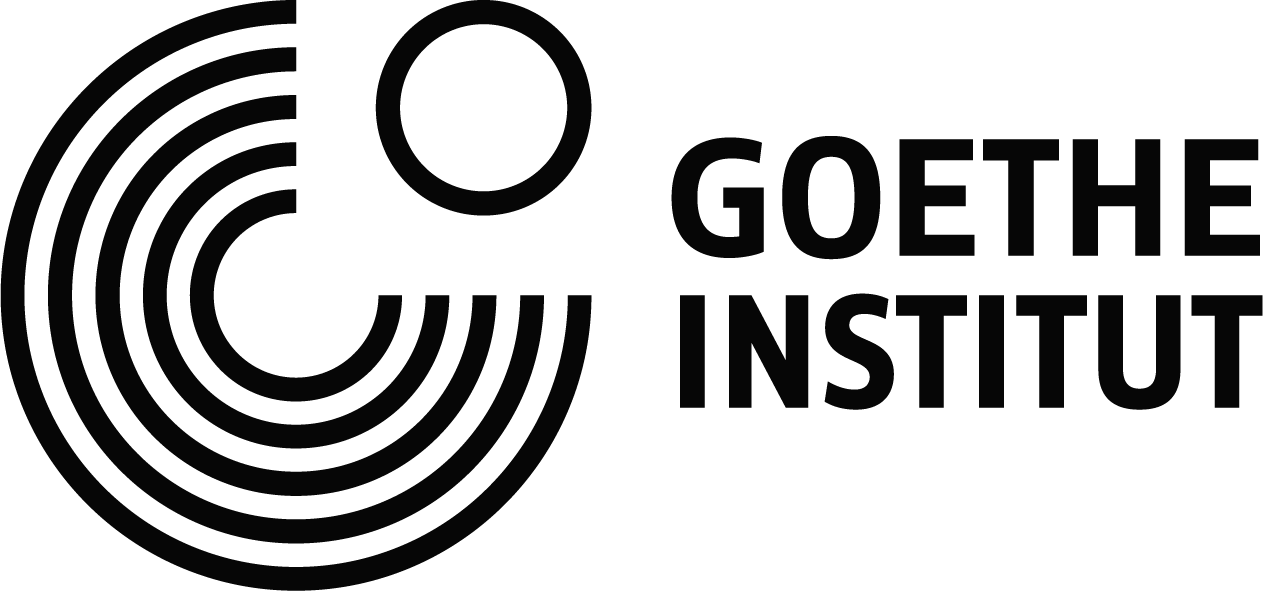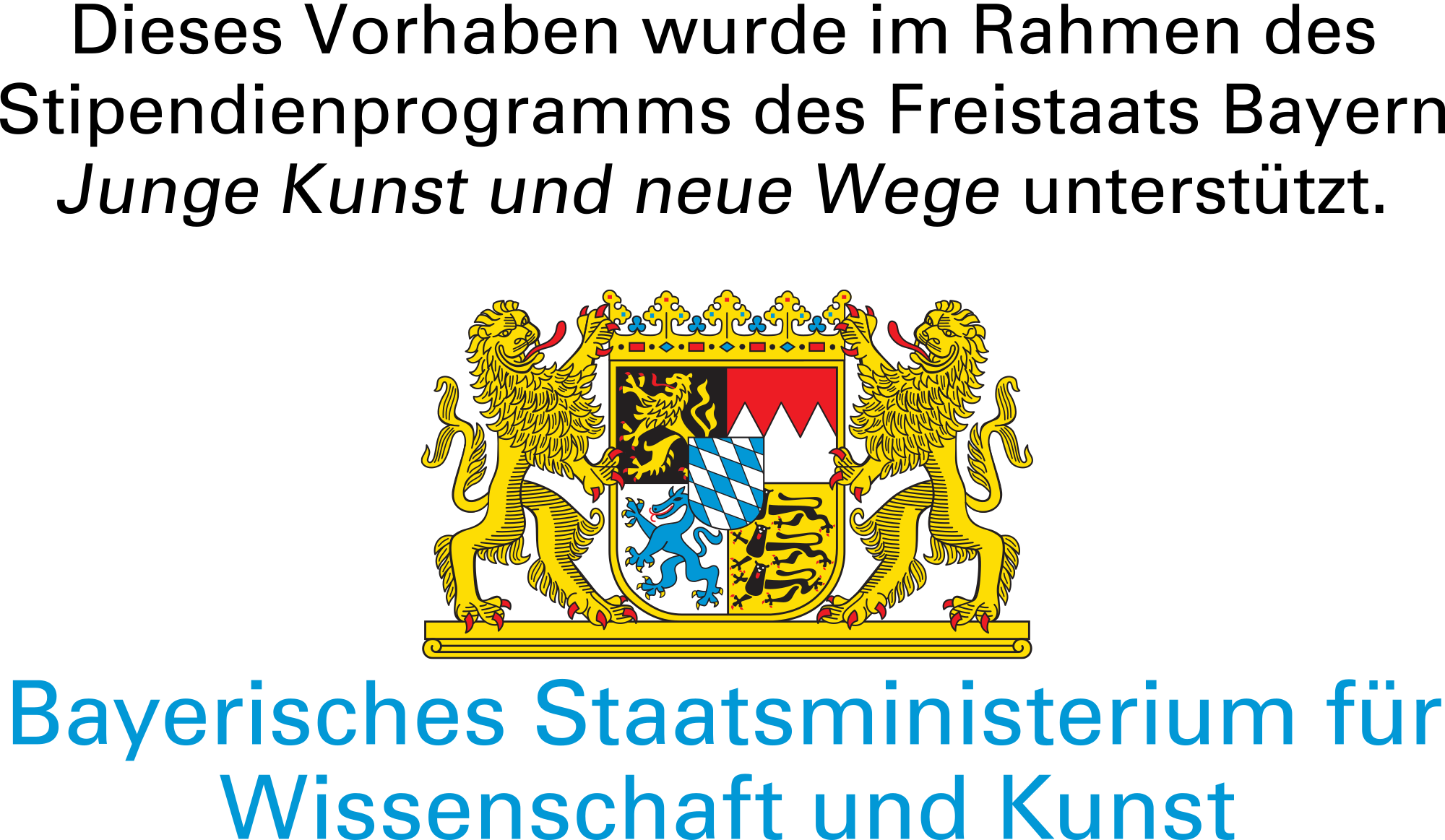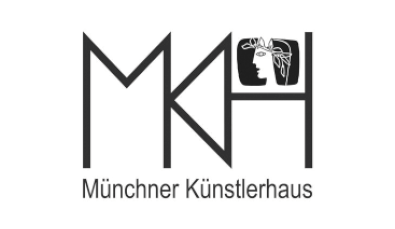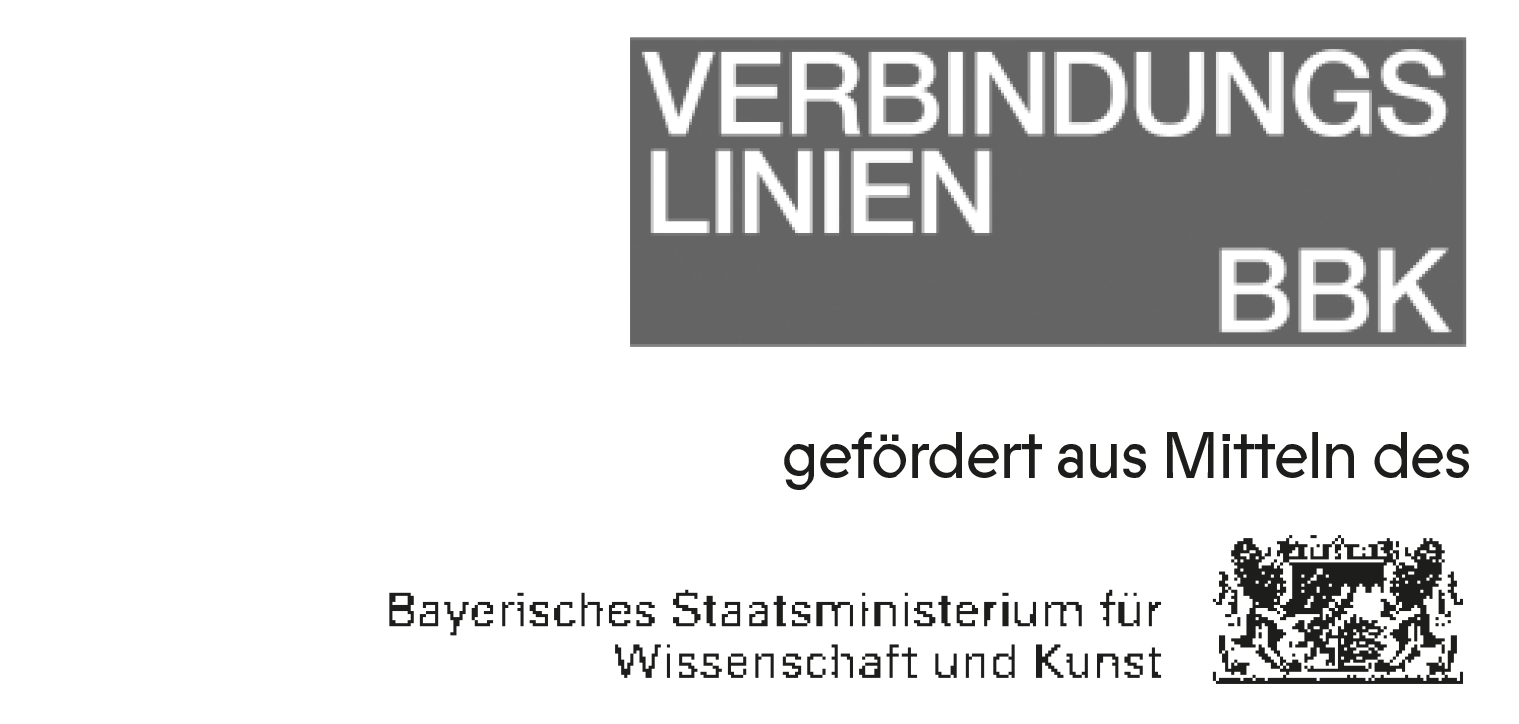wanttostaywhereIhaveneverbeen
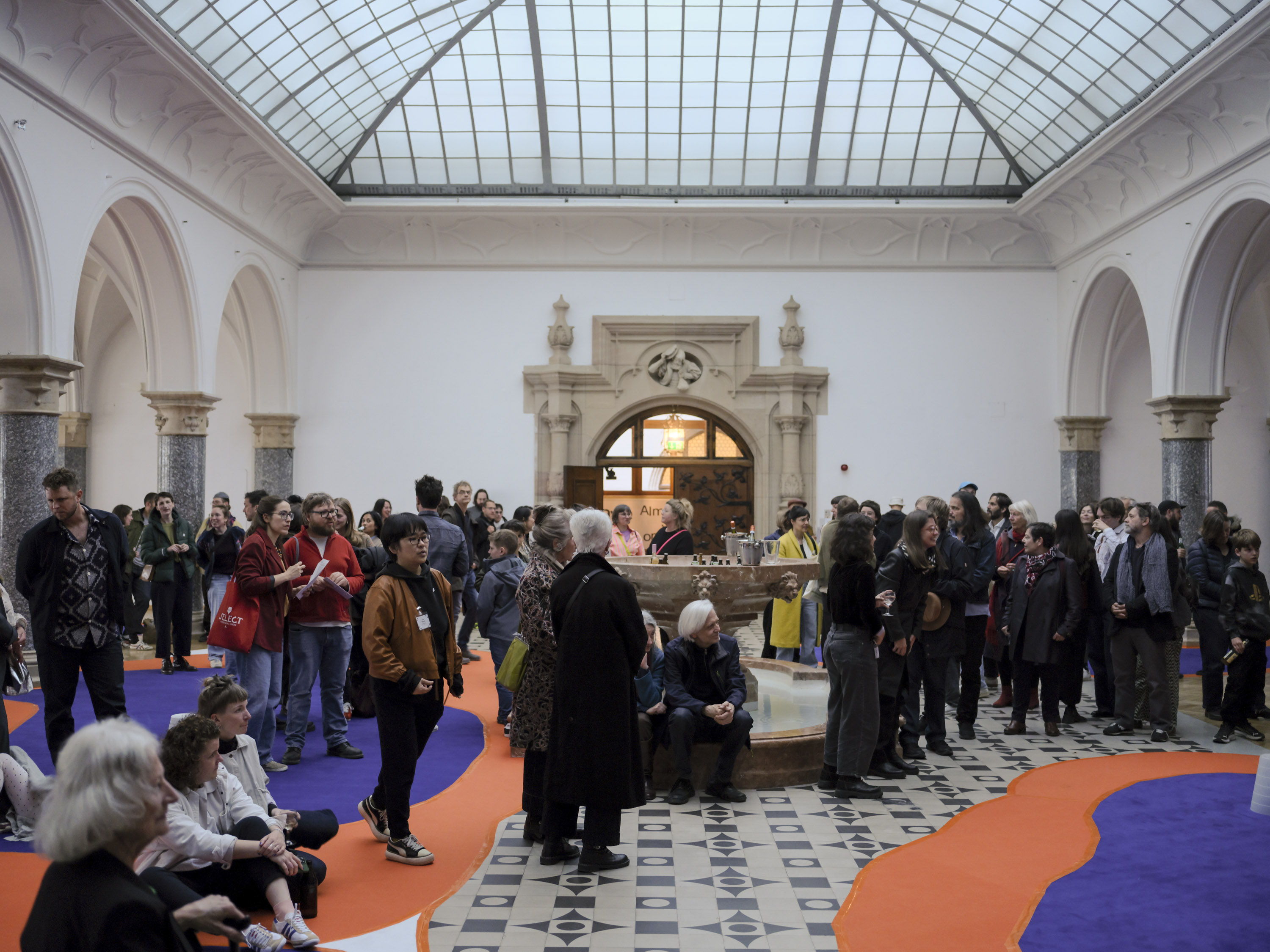
Artist exchange programs have a long tradition. The opportunity to live and work in a foreign place for a certain period has not lost its appeal. At the Rathausgalerie, three artist residencies came together, all initiated by Munich-based artists: AlmResidency, Jet Leg, and LongegaProject. The exhibition focused on collective collaboration, international exchange, and the crossing of boundaries.
A modular “installation on wheels” was created, accompanied by a diverse supporting program in German, English, and German Sign Language. With city-wide interventions, Want to stay where I have never been enters public space. At the facade of the Department of Arts and Culture in Burgstraße 4, three flags by artists who could not participate in person will be displayed.
Participating artists include Magdalena Jooss, Janina Totzauer, Carina Müller, Danilo Bastione, Siyoung Kim, Youlee Ku, and Fabian Feichter, as well as international guest artists Hyeyoung Ku, Irene Macalli, and Thandi Pinto, who are part of the residency program at Ebenböckhaus in Munich. Also invited: Shaqa Bovand, artist duo “Laumkon”, Maria Mbereshu, Rebecca Moccia, and Matteo Pizzolante.
The program is commissioned by Verbindungslinien of BBK Bayern (funded by the Bavarian State Ministry for Science and the Arts). It is supported by the Erwin and Gisela von Steiner Foundation, the Department of Arts and Culture of the City of Munich, and the Coordination Office for the Implementation of the UN Convention on the Rights of Persons with Disabilities (UN-CRPD) of the City of Munich. It takes place in cooperation with the City of Munich Residency Program / Ebenböckhaus.
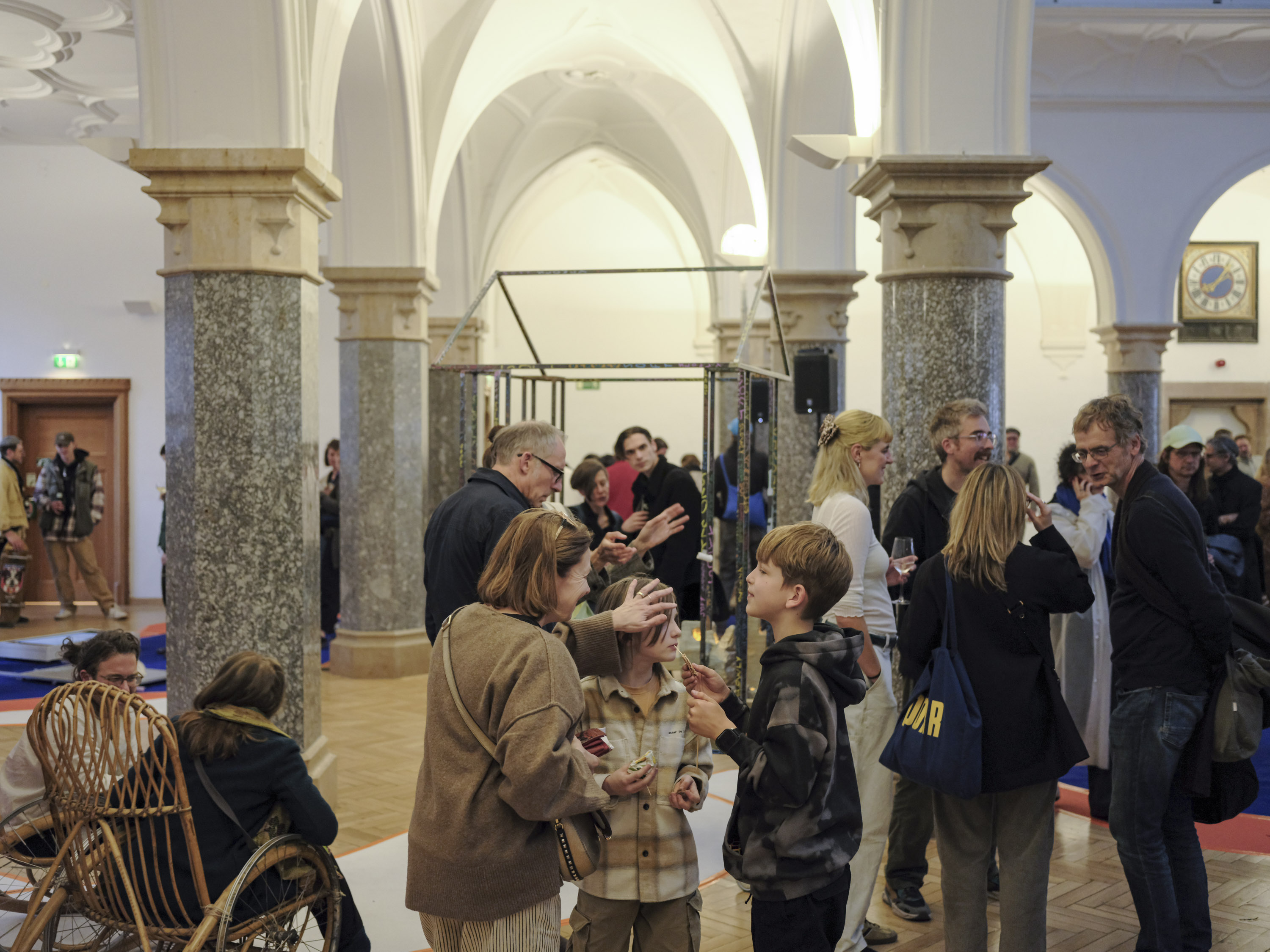
DANILO BASTIONE
AEDICULA
Metal, polyurethane, seeds, soil, stones, concrete.
This work recalls “devotional niches” or small chapels found in some of the world’s most historically rich cities. These miniature temples are used to honor or remember personalities or symbols of cults—religious or secular. The piece invites us to venerate something immaterial, yet deeply meaningful in our society: time.
Inspired by the notion of a traveler who experiences the world through movement, this Aedicula is a small temple of resistance—against turbo-tourism, hyper-productivity, and chronic stress. An ode to time as a shared and precious resource. A place of focus, reflection—and waiting for time that doesn’t pass.
At the core of Bastione’s current artistic project is the engagement with “New Materialism” – a philosophical approach that focuses on the interrelations between matter, culture, and social structures. His works are consciously provisional and “in progress,” while also poetic—and to a certain extent, romantic.
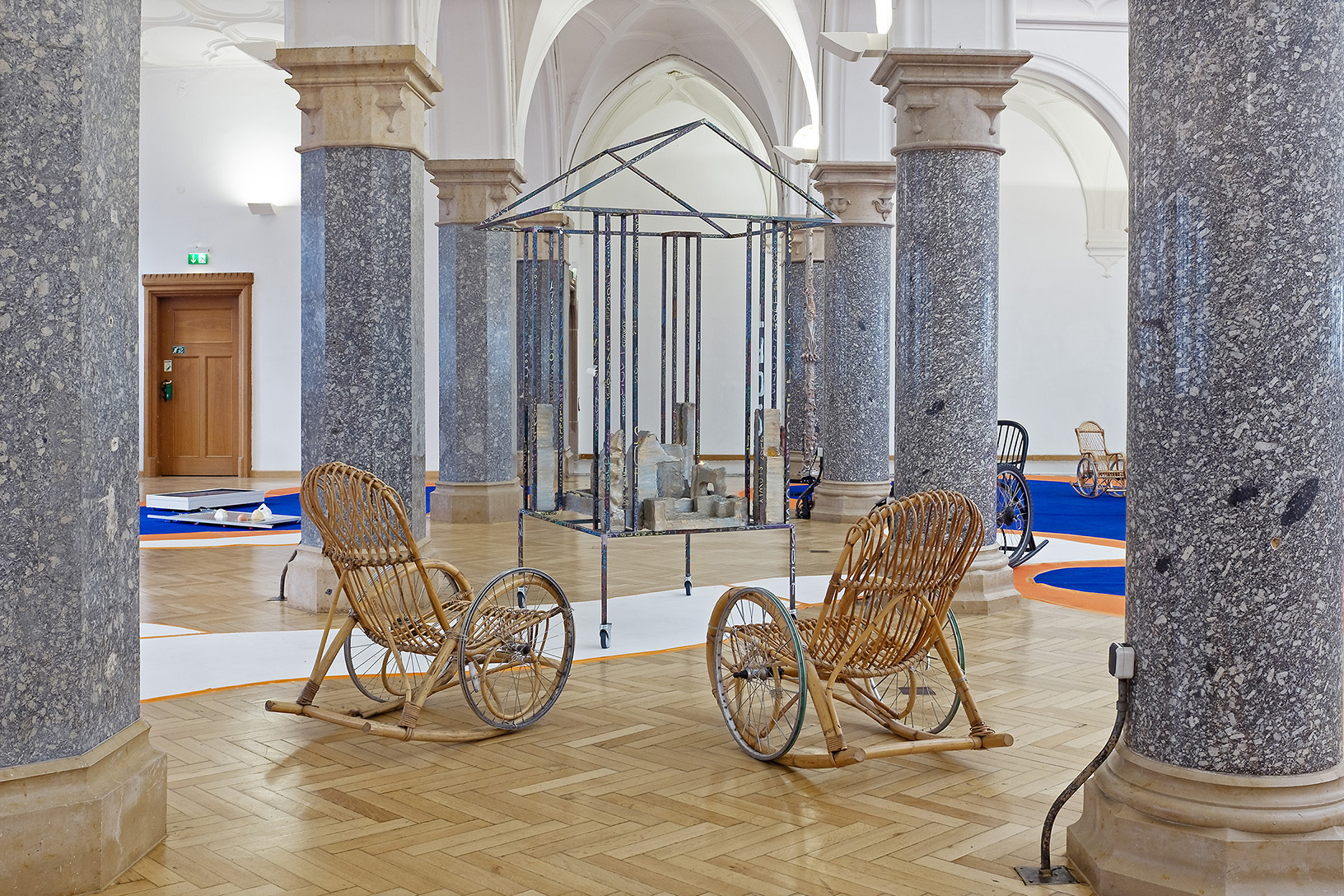
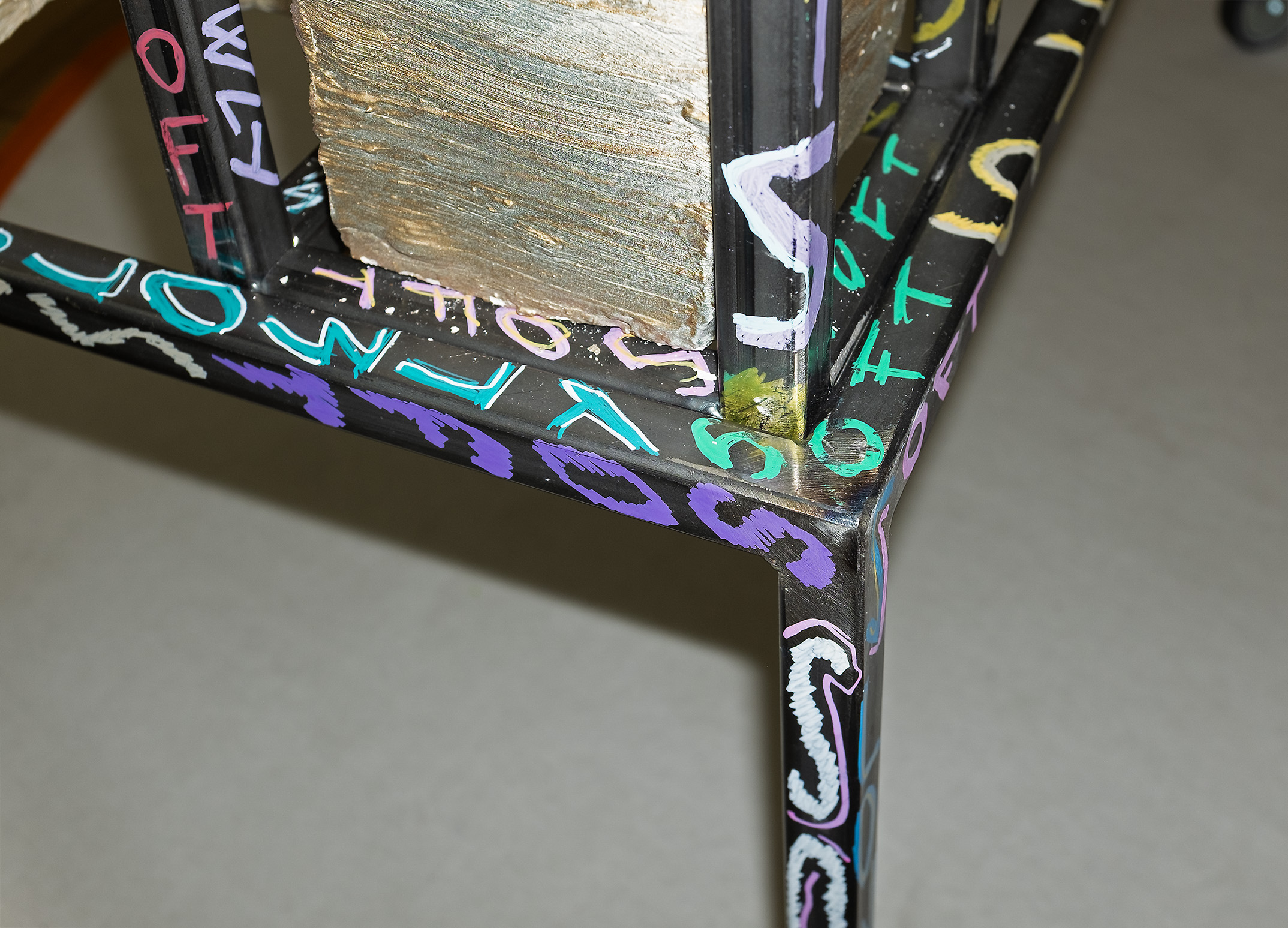
HYEYOUNG KU
IN THE CAR IN FRONT OF ME
Two-channel video installation
During her residency in Munich, the artist continued an ongoing series that treats music and video as a single genre. Typically, her practice during residencies includes writing new lyrics inspired by the host country or region, reinterpreting familiar songs in alternative ways, or creating site-specific media works based on existing songs.
This process becomes a performative act, circulating life and creation through the artist’s body. Using language and music, she seeks to understand present space and time while forming a network of connections and participation with unknown people and elements.
In this residency, she quickly selected a German song, learned it, and documented the experience as a music video, embedding the specific time and space of the residency into the work. One video shows the preparation—song choice, learning the language, rehearsing—within the lived residency space. The second video presents the final result: the artist performing the song in a music video.

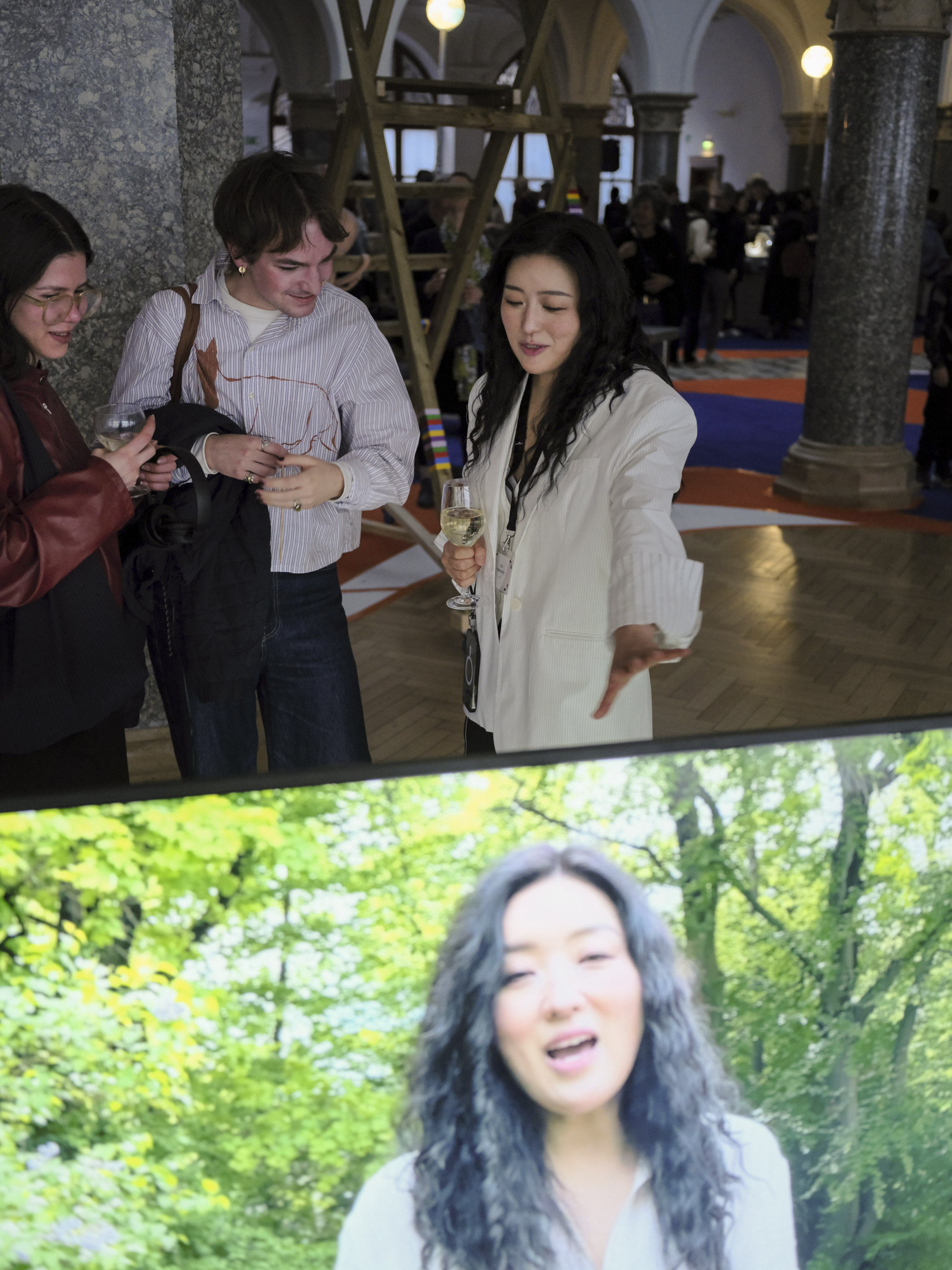
FABIAN FEICHTER
MEMOIREN VON ZWEI GEWÖHNLICHEN LATERNEN
Metal, polyurethane, seeds, soil, stones, concrete.
There are two streetlamps to the left and right of my studio in Longega, South Tyrol, that have stood there since before I was born. They cannot see each other, as a curve in the road blocks the view, yet every evening there is a light signal that allows each to sense the presence of the other.
Around one of the lamps, new roads and houses have been built, but it remained unchanged, bearing only slight traces of age. The other has blended into nature, embraced by plants and grass — a microcosm, alive and marked by time.
Despite the changes, they have experienced much together – floods, the destruction of the forest by wind and bark beetles, and the coming and going of countless people. And although they gaze from the same perspective, over time they have become entirely different.
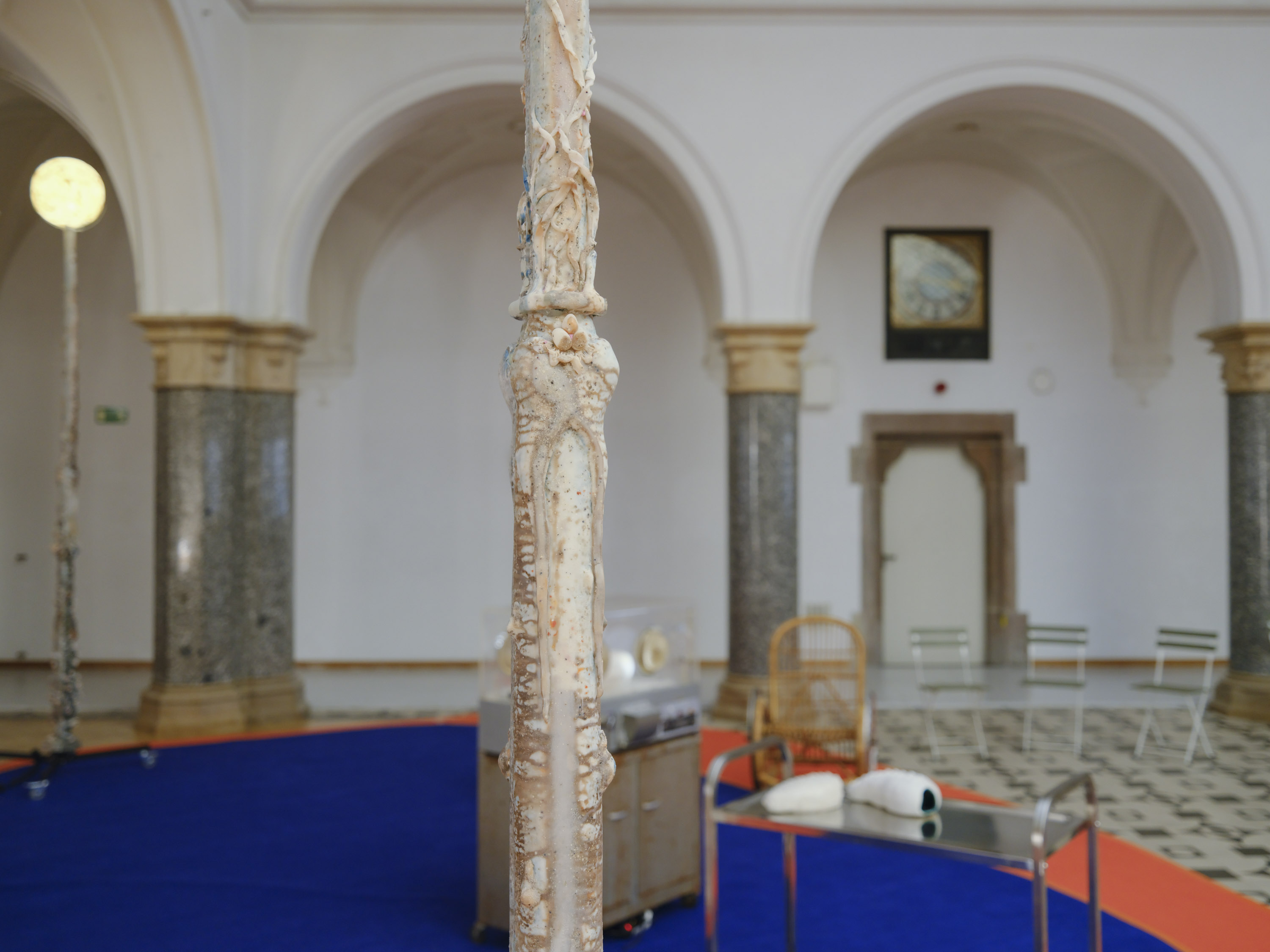
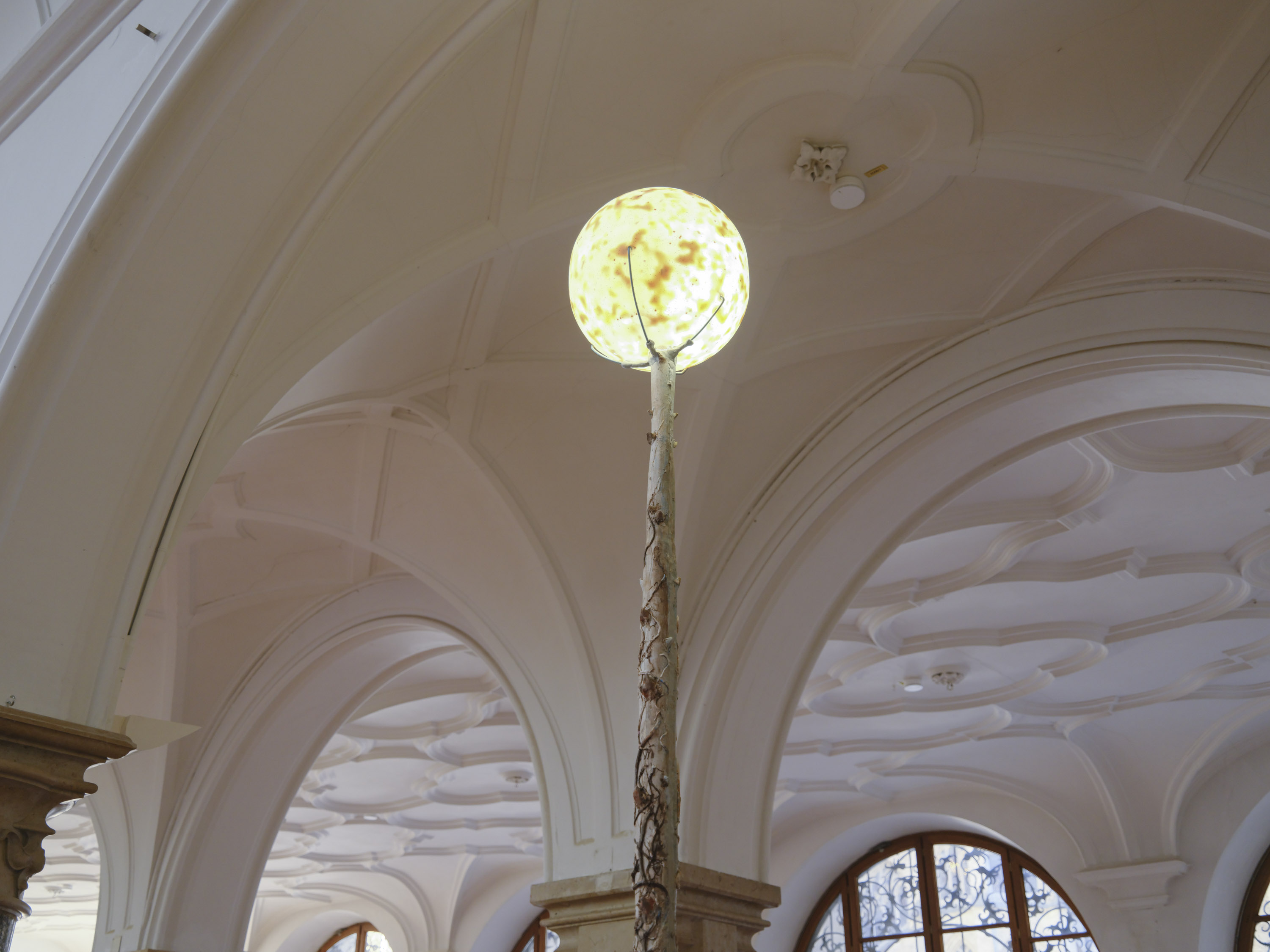
YOULEE KU
PRIMÄRKONSUMENTEN
Polymer gypsum, metal, organic materials, and live video feed from the river in Longega / 2025
Youlee Ku explores the complex interconnections within the natural pyramid. Small organisms like the bark beetle, aided by dry summers and mild winters, survive in increasing numbers and cause damage to forests. This disrupted balance sets off a domino effect:
As the trees weaken, their ability to store water diminishes, leading to flooding during heavy rainfall. The artist draws on personal experiences from Longega in South Tyrol to make visible the fragility of nature.
Her work challenges traditional understandings of hierarchies in nature and shows how nature and humans are entangled in a fragile, uncontrollable cycle. In a system that escapes human control, small and seemingly insignificant actors become powerful influencers — urging us to rethink our notions of intervention and control.
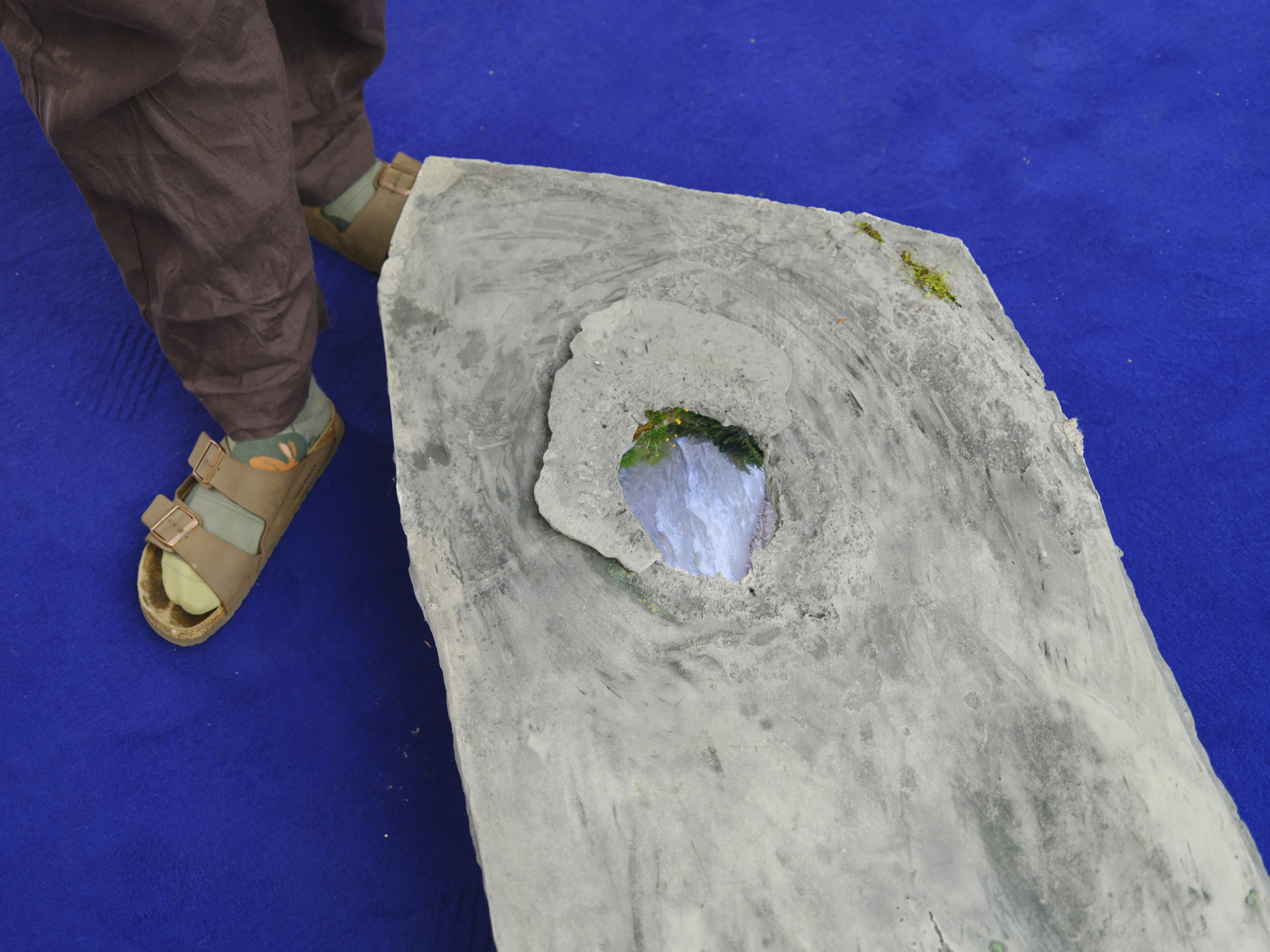
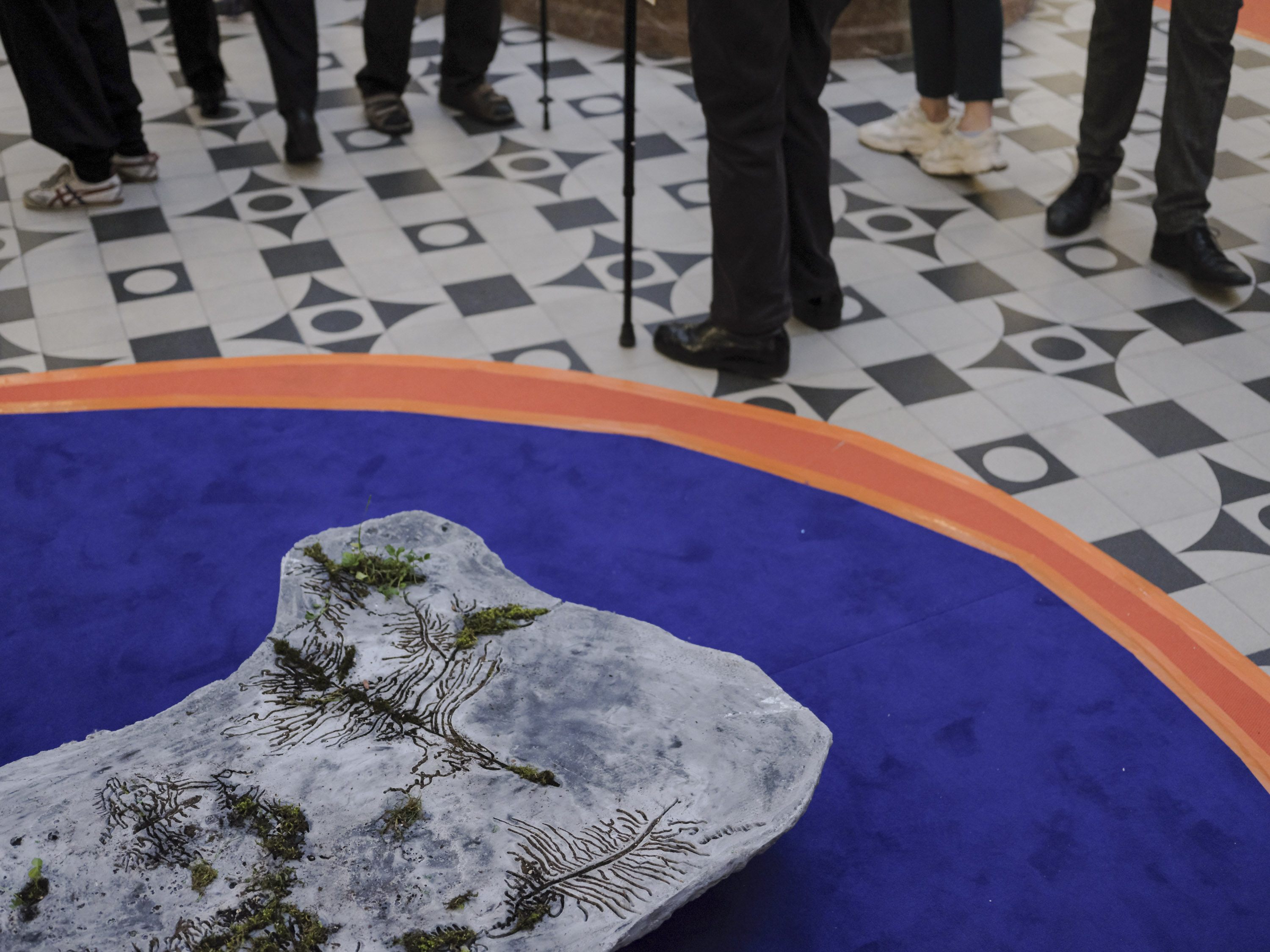
MAGDALENA JOOSS
HÄTTE ER GEWUSST, DASS DAS NICHTS NICHT NICHTS IST, WÄRE ER VIELLEICHT SITZEN GEBLIEBEN NEBEN DEM WOLF.
Photography printed on linen, embroidery, scanning electron microscopy
Lab tests usually provide answers – but Magdalena Jooss, using scanning electron microscopy, uncovered new questions instead. Her image of a jagged grayscale world evokes worm tunnels or lunar landscapes. In fact, it is a highly magnified image of tree bark, found at the site of her installation “Selfie Park” (2016) in the Bavarian foothills.
Ten years later, she extracted a piece of this bark — still bearing the marks from the original installation — and analyzed it in a lab. In the microscope’s vacuum, a new visual realm emerged.
For Jooss, the vacuum does not symbolize an end but the origin of new image worlds. Her work interweaves layers of meaning, natural processes, and technology into a single black-and-white fabric image, embroidered with a crest: a trophy of microscopic vision.
She asks: What remains when we probe to the depths of nature?
Perhaps simply nature itself — undeterred, autonomous, and uncontrollable. Jooss was reminded of Atreyu from Michael Ende’s The NeverEnding Story — what if he hadn’t fought the Nothing, but recognized it as something?
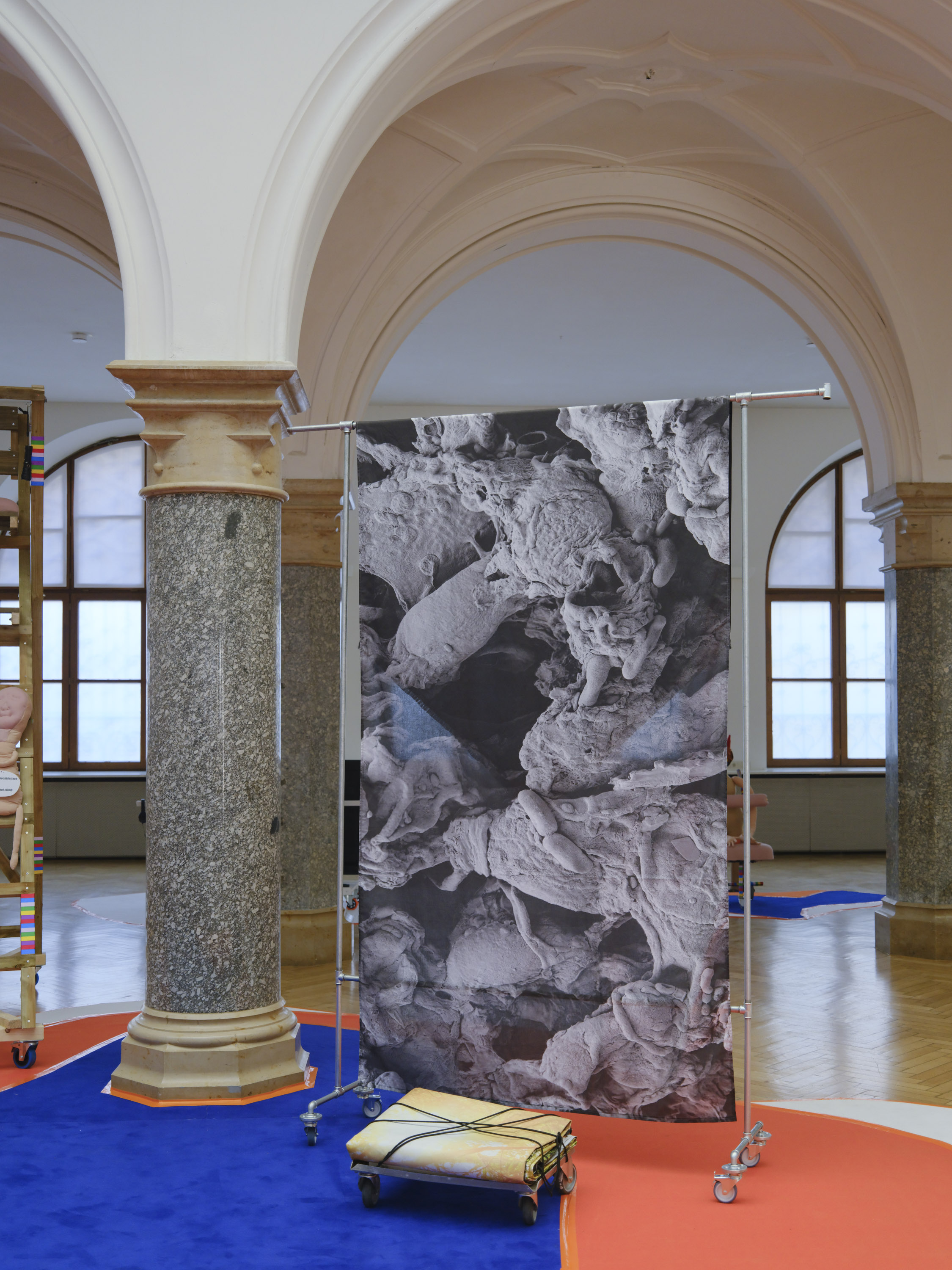
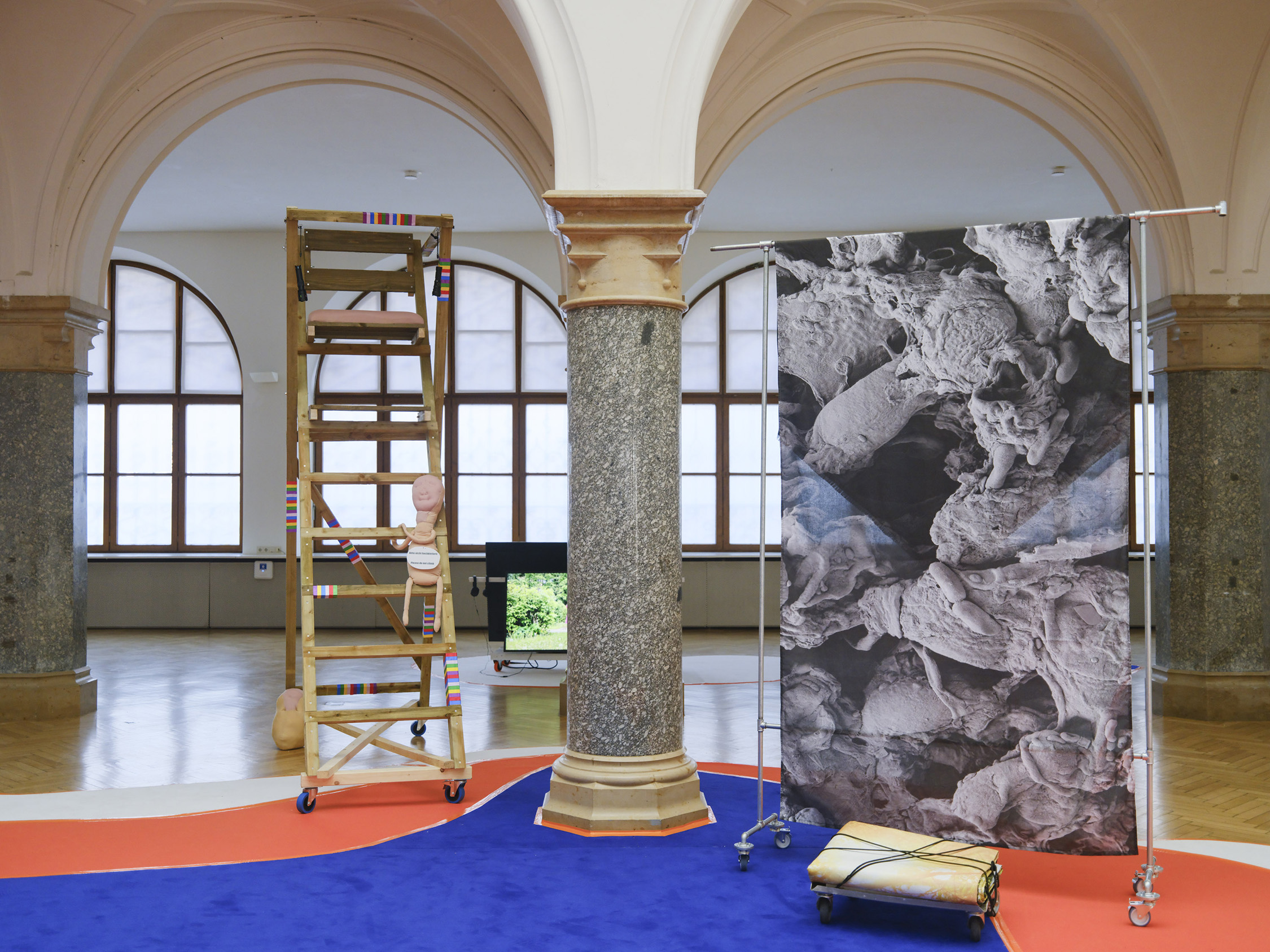
Siyoung Kim
I WILL ACCOMPANY YOU
Fabric, foam, wheelbarrow, ribbon, Krampus mask by Diana Ebster – Private collection of Siyoung Kim
DINING TABLE
Wood, ribbon, fabrics, filling material
TREE STAND
File folder shelf, acrylic paint, ribbon
Siyoung Kim presents three interactive works that address the dialogue between cultural identity, collective memory, and participatory experience.
The first piece, “I Will Accompany You”, is a movable chair equipped with dolls, a Krampus mask, a lullaby, and a soft cushion. Visitors are invited to take a seat — the chair can be pushed or pulled by others. This poetic gesture creates space for closeness, trust, and the sharing of stories.
The second piece, “Dining Table”, is a three-tiered, rotating table, lovingly painted with ornamental designs. It provides space for dishes from different countries and becomes a place of intercultural exchange, enjoyment, and connection.
The third installation, “Tree Stand”, is a brightly decorated elevated seat adorned with cushions and ribbons. From this vantage point, visitors gain a wide view of the exhibition — a shift in perspective that invites curiosity, playfulness, and reflection.
All three works invite viewers to experience art sensually and collectively.
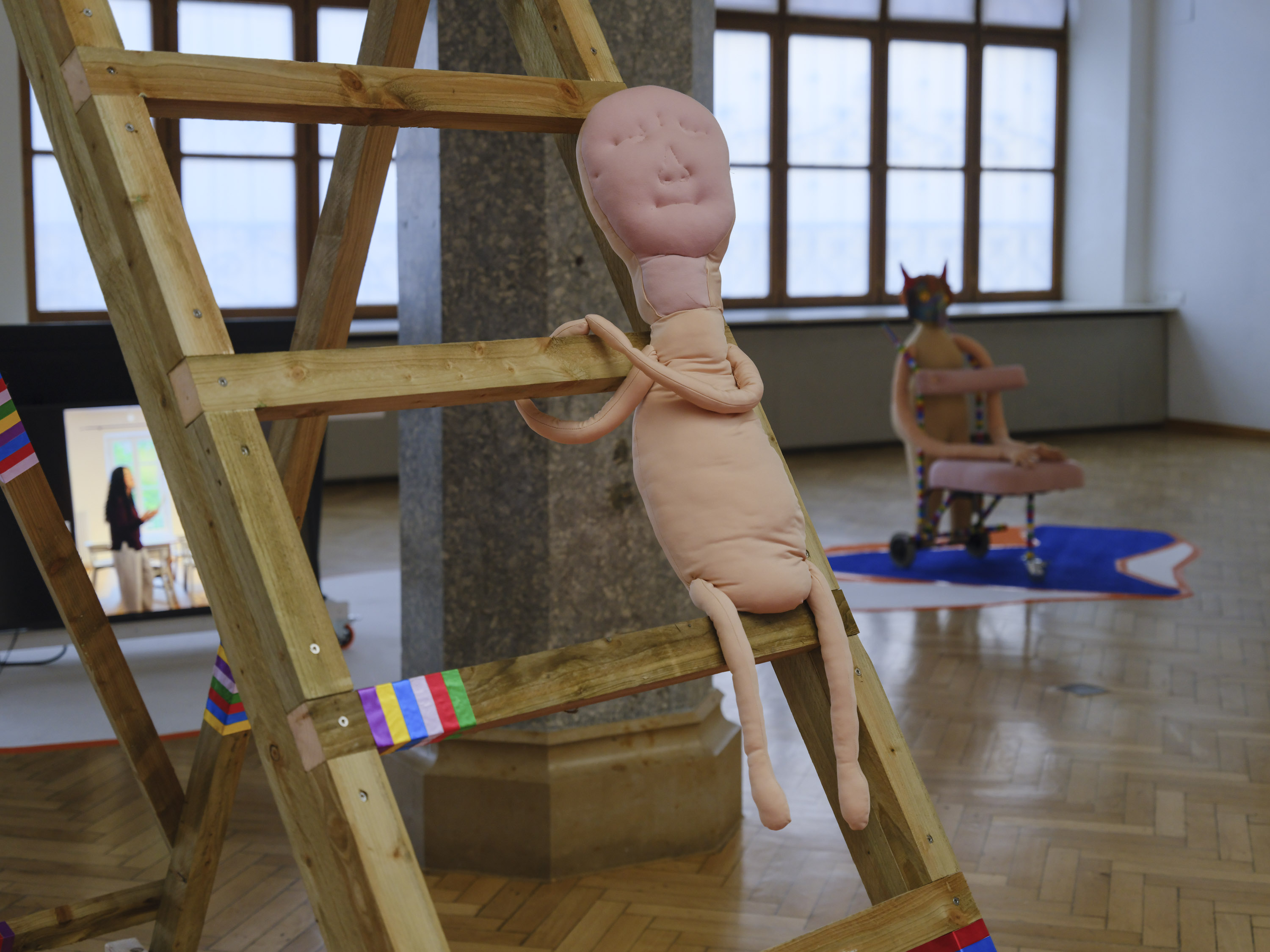
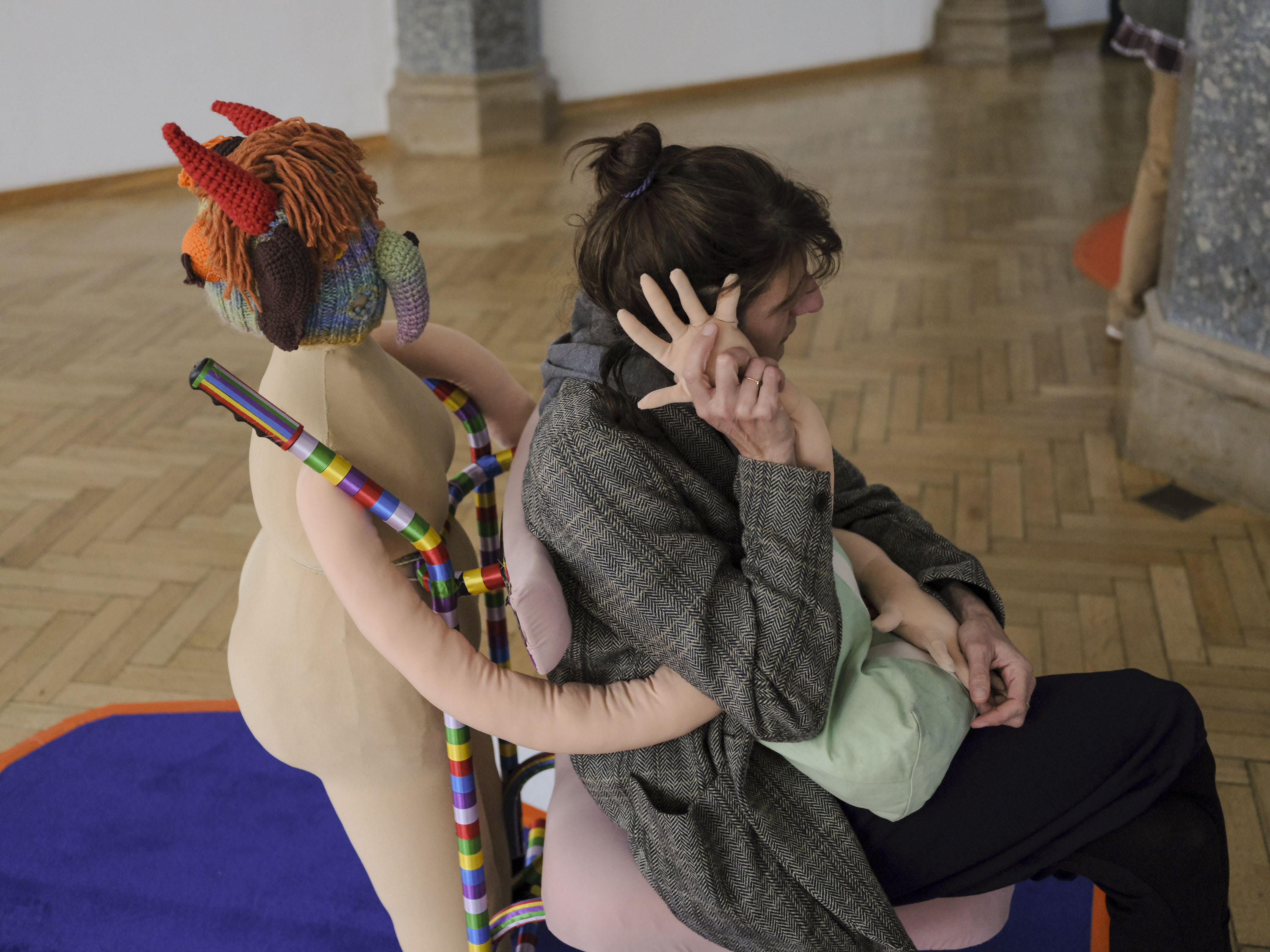
THANDI PINTO
MAPA DE SAUDADES - THERE ARE PLACES THAT WE HAVE NEVER BEEN, BUT CAN BE VISITED IN OUR DREAMS
Collage
This project explores the dreams of young Mozambicans, known as the Madjermans, who returned in the 1990s to Mozambique after their time in the German Democratic Republic (GDR) as part of socialist cooperation programs. In East Germany, they experienced stability, education, and urban life — some even started families there.
But upon returning to war-torn Mozambique, which was transitioning toward neoliberalism, they were met with uncertainty, loss, and disillusionment.
Many had to leave suddenly and without warning — no farewells, no personal belongings. What remains are fragmented memories and dreams that summon a lost world. This work reconstructs the subconscious of those caught between two realities — a Germany that no longer exists, and a Mozambique that has profoundly changed.
“My own time in Germany allowed me to enter this in-between space — the place the Madjermans return to in their dreams, even though it remains unreachable in waking life.”
Most of them never received payment for their work abroad. Today, they protest weekly for justice. But beyond that struggle, I want to tell the story of lives filled with beauty, dignity, and dreams — memories that deserve to be preserved.
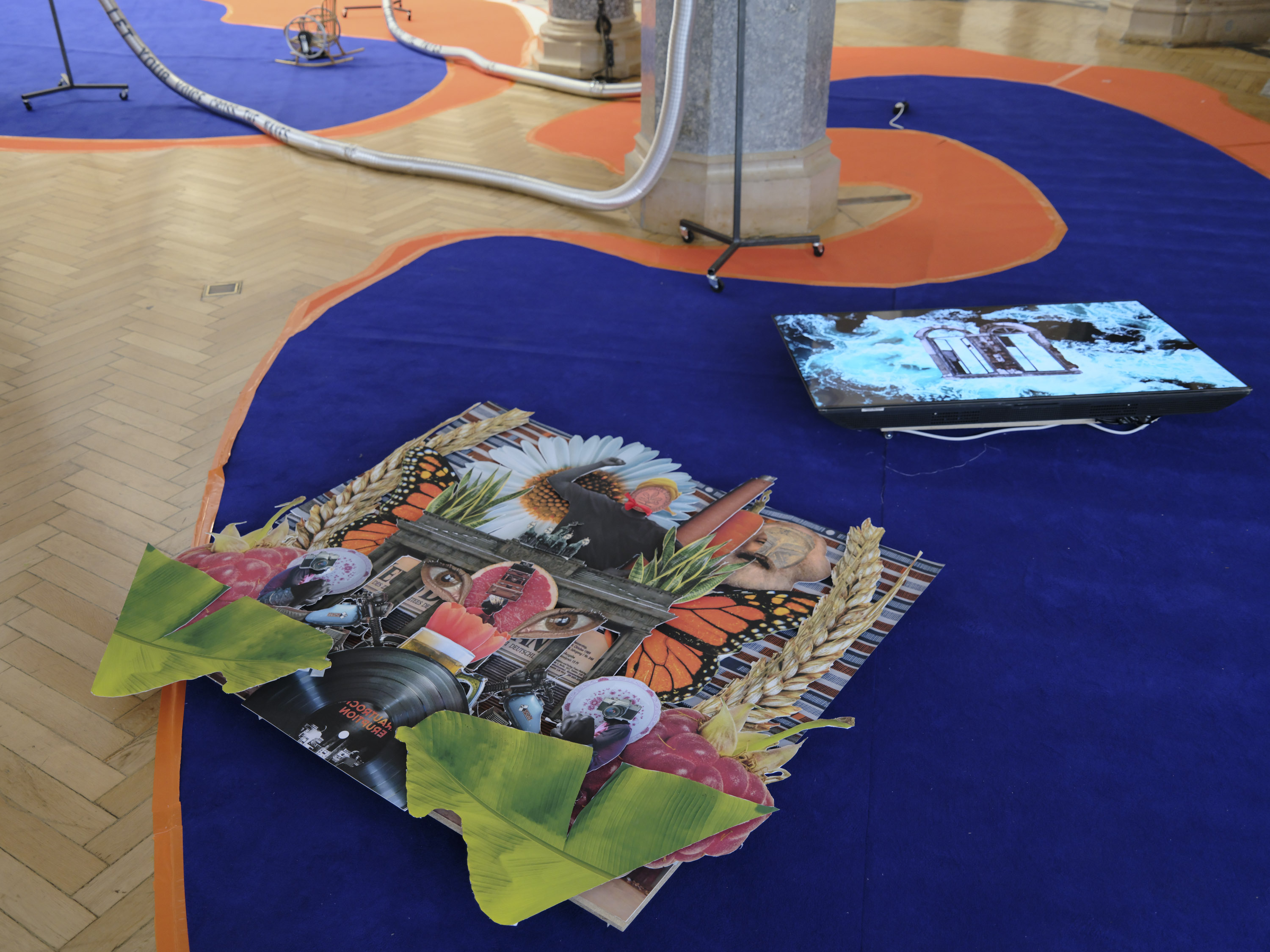
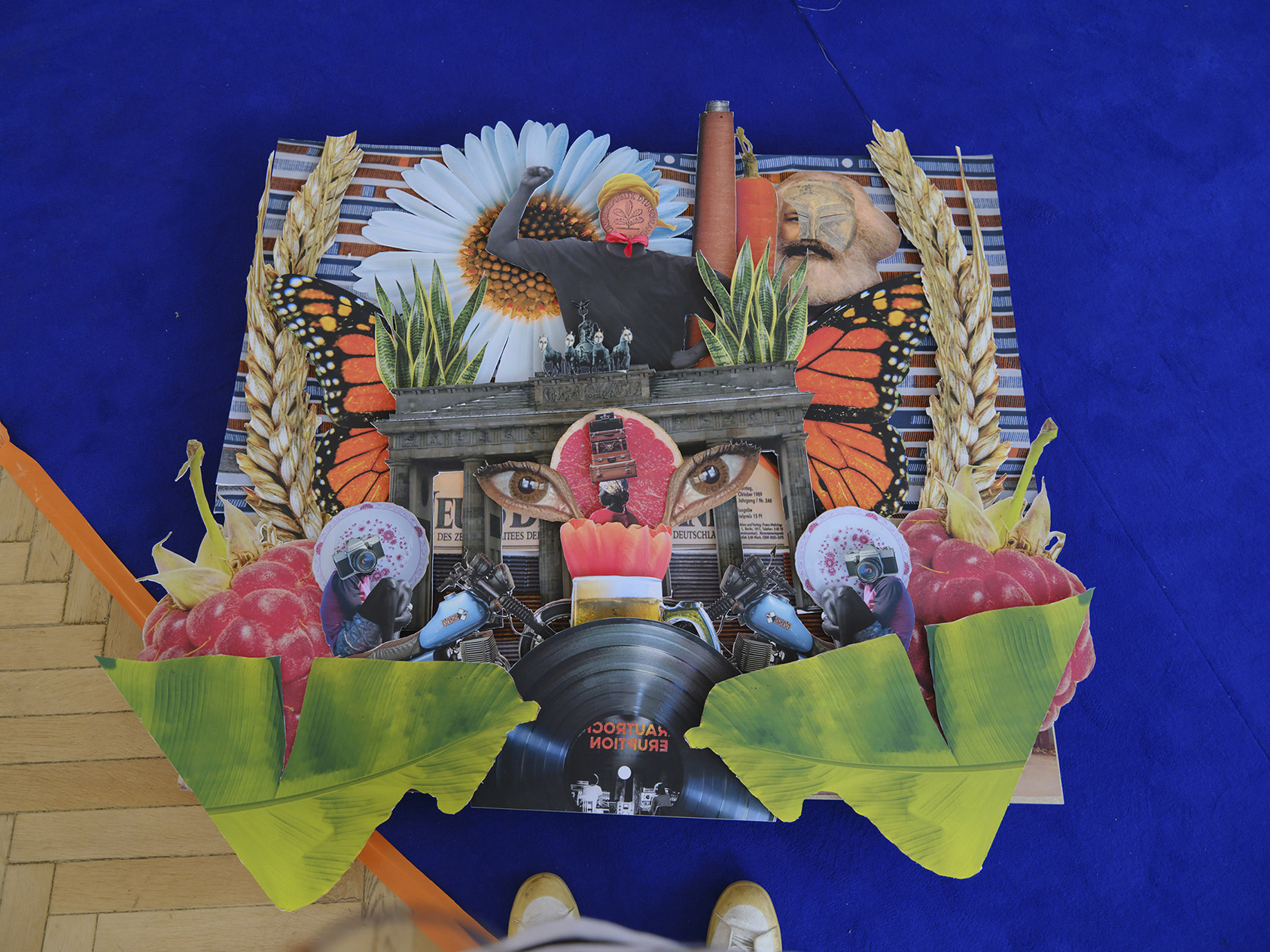
MATTEO PIZZOLANTE
TWIN SCULPTURES
Plaster, aluminum – 60 x 55 x 80 cm
Twin sculptures, identical in form but made of contrasting materials — aluminum and fiberglass — rest on opposing pedestals: one atop plaster, the other on fabric. Each sculpture is mounted on a wheeled cart, allowing for movement throughout the exhibition space.
This configuration encourages a reflection on the relationship between material and function, drawing attention to contrasts in weight, texture, and stability, while questioning the role of support structures and mobility in shaping an object’s presence and potential use.
The rational, functional shape of the sculptures suggests they were designed for a specific purpose — even if that purpose remains undefined — and invites viewers to rethink the boundary between utility and perception.
At the same time, the works present themselves as fragile constructs in a dialogic relationship with the space they occupy. This interplay explores contradictions and disrupts sensory expectations, as the sculptures’ opposing qualities — industrial yet handmade, mobile yet grounded — evoke a state of perceptual disorientation and conceptual ambiguity.
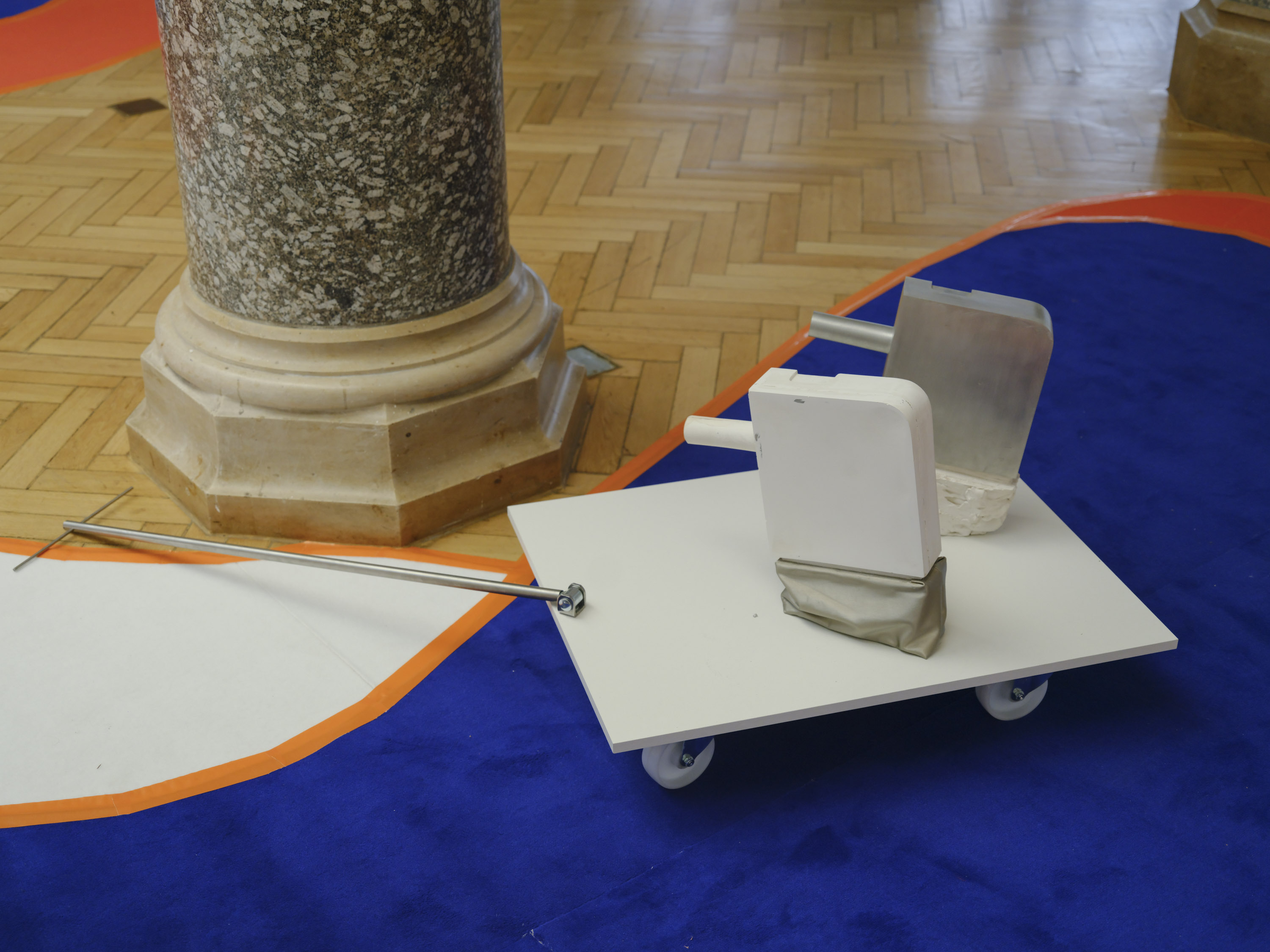
JANINA TOTZAUER
BRUT
Ceramics and video
320x280 cm, each approx. 3x40 cm
Stainless steel, aluminum, Raspberry Pis, plastic, felt
The Brut series combines video and ceramic sculpture into so-called techno ceramics — a dialogue between an ancient, durable material and a fast, digital image world.
In Brut, Totzauer creates a world of hybrid creatures — beings somewhere between cell, egg, and amphibian — alien embryos fresh from outer space. They linger in liminal states of transition: in the incubator awaiting birth, on the butcher’s table awaiting death.
The exposed innards of the dying animal on the butcher’s slab plunge us into the depths of human anatomy. Microscopic footage of sperm transforms into an inner landscape, giving the intestines a disturbingly human quality. In another being’s belly, the viewer witnesses a final digestive process — just before the creature itself is prepared.
An unborn being peers out with a weary eye from its warm incubator. But the eye itself is an endoscopic view of a colon — a glimpse into the darkest corners of human existence.
Rare thermal imaging footage shows the egg-laying of a previously unknown alien species in a Bavarian forest near Miesbach. The hybrid eggs made their way directly from there into the exhibition.
Totzauer’s imaginative world explores the political and feminist dimensions of bodily colonization, dissecting themes like otherness, belonging, and identity.
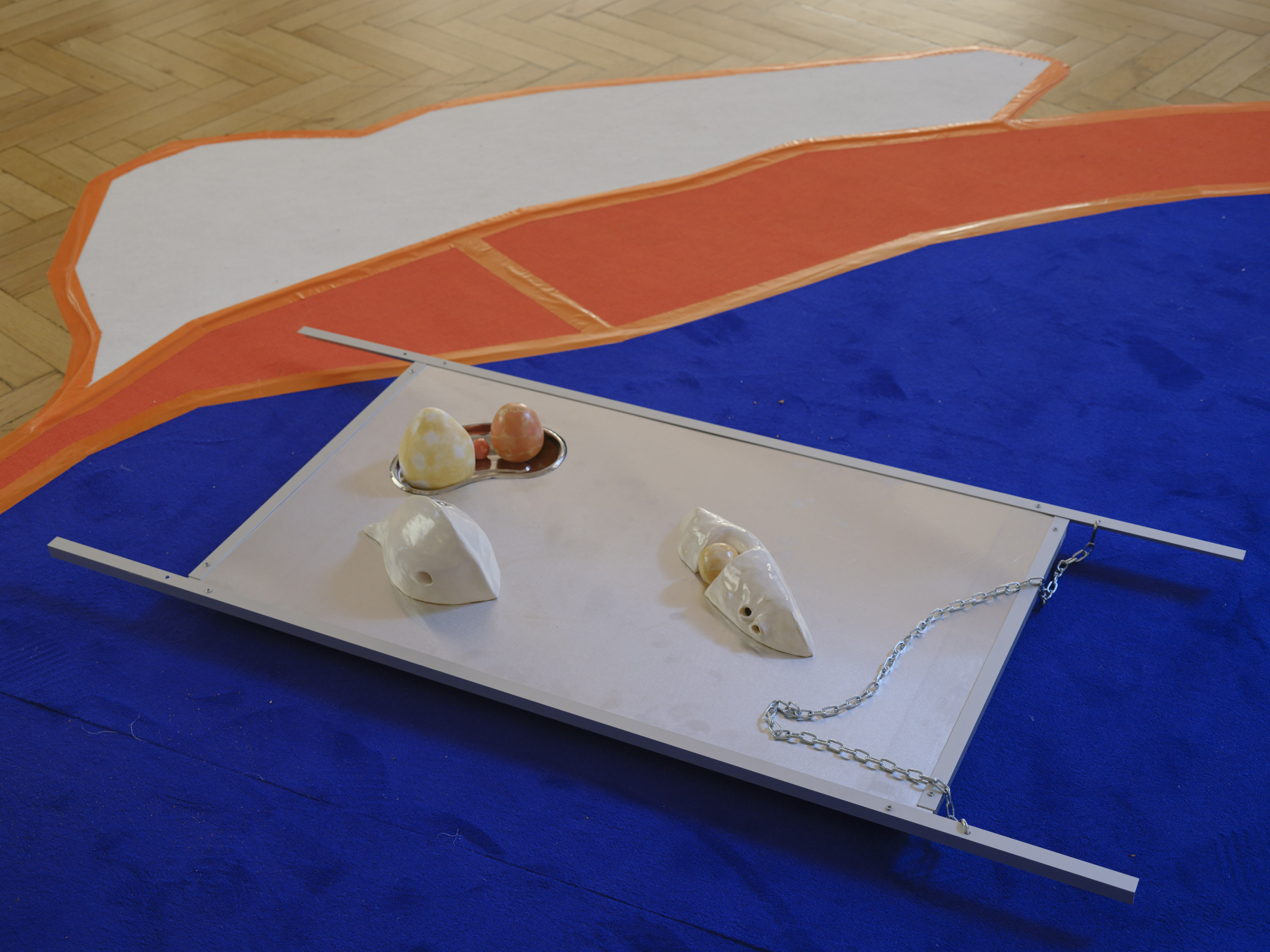

CARINA MÜLLER
MAIL BOX XL
Various boxes – 460 x 333 x 174 mm, various materials
MAIL BOX XL is a newly launched mail art project that connects female artists worldwide. Initiated only a few weeks ago, the project involves sending packages to artists across the globe — offering them a chance to participate in an exhibition without needing to be physically present.
It provides an alternative platform for artistic participation and exhibition practice — especially valuable in times of restricted mobility or a lack of local exhibition spaces.
The project began in response to a city council decision to temporarily transform the former town hall building into a post office — a space for interim use.
In collaboration with AAP, Archive Artist-Publications, @archiveartistpublications
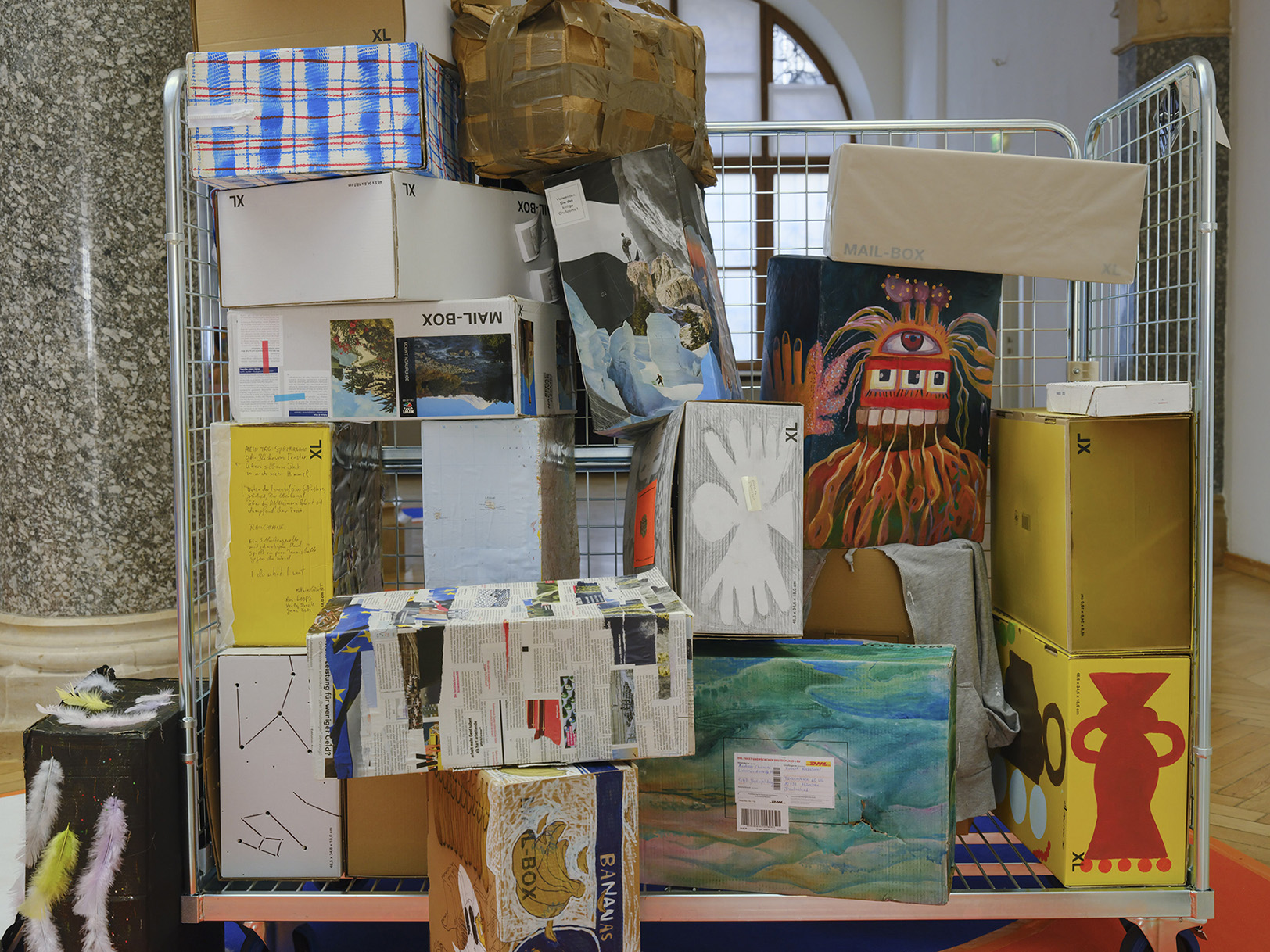
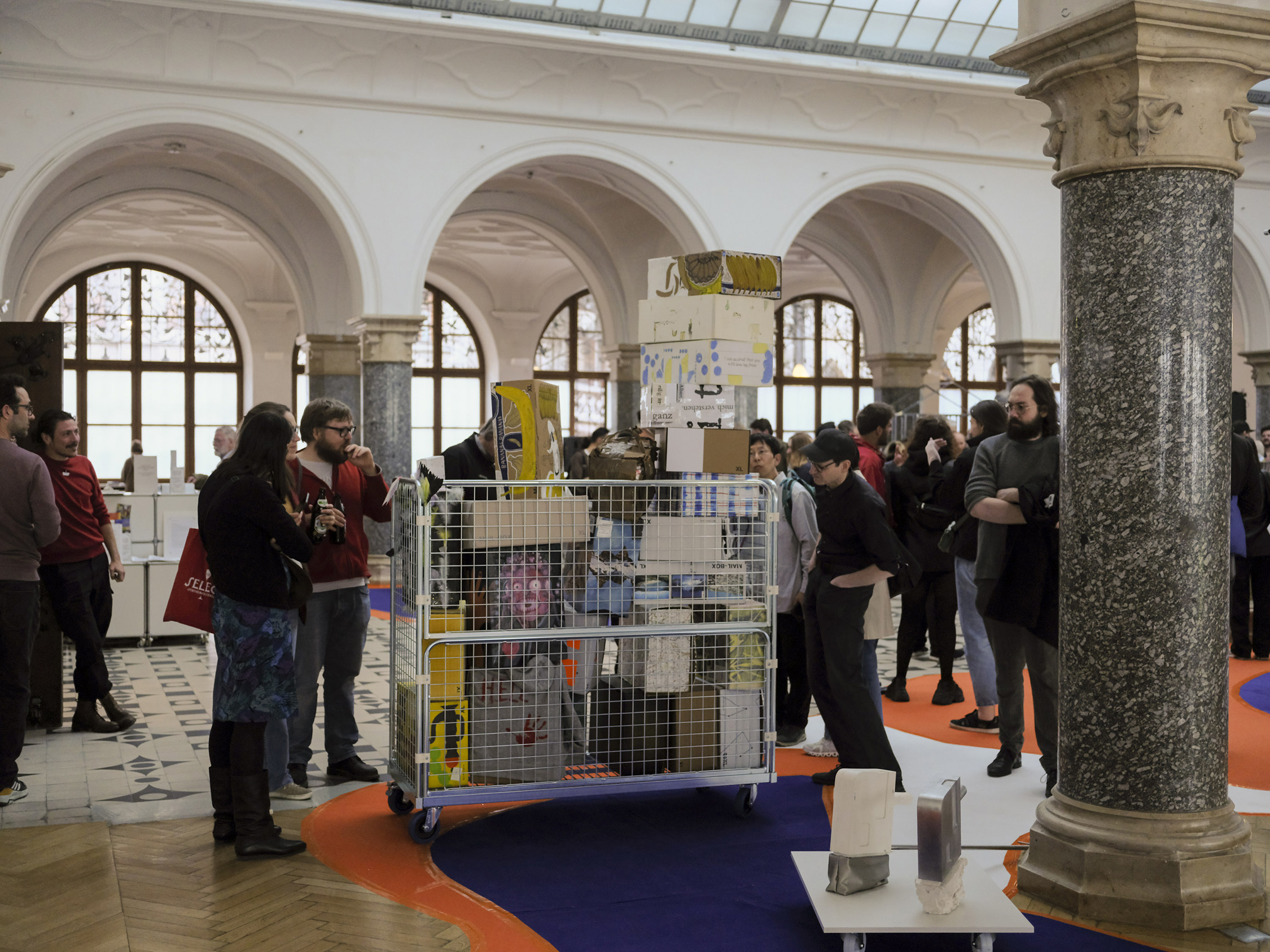
REBECCA MOCCIA
MINISTRIES OF LONELINESS
Multichannel audio-video installation
Inspired by the establishment of the Ministry of Loneliness — first created in the UK in 2018 and later adopted in countries like Canada and Japan — Ministries of Loneliness reflects on the political and social structures that shape both the emotional condition and societal perception of loneliness today.
This non-fictional multichannel film is based on extensive research conducted in various countries, including Italy, the United States, Japan, South Korea, and the United Kingdom.
It juxtaposes diverse materials collected throughout the research — from parliamentary archives to academic and narrative literature, as well as direct and indirect testimonies and experiences.
The work is accompanied by an original soundscape by Renato Grieco.
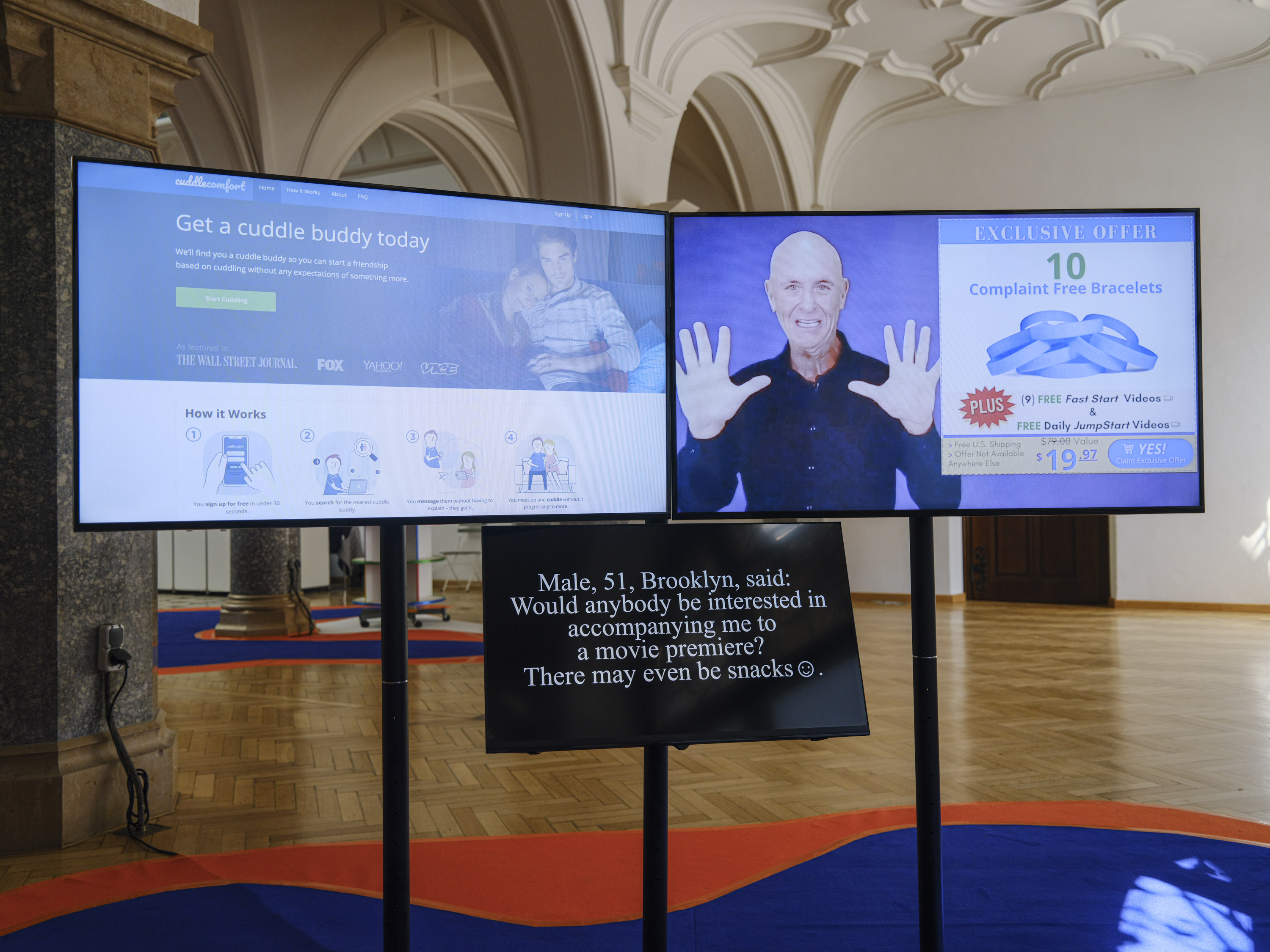
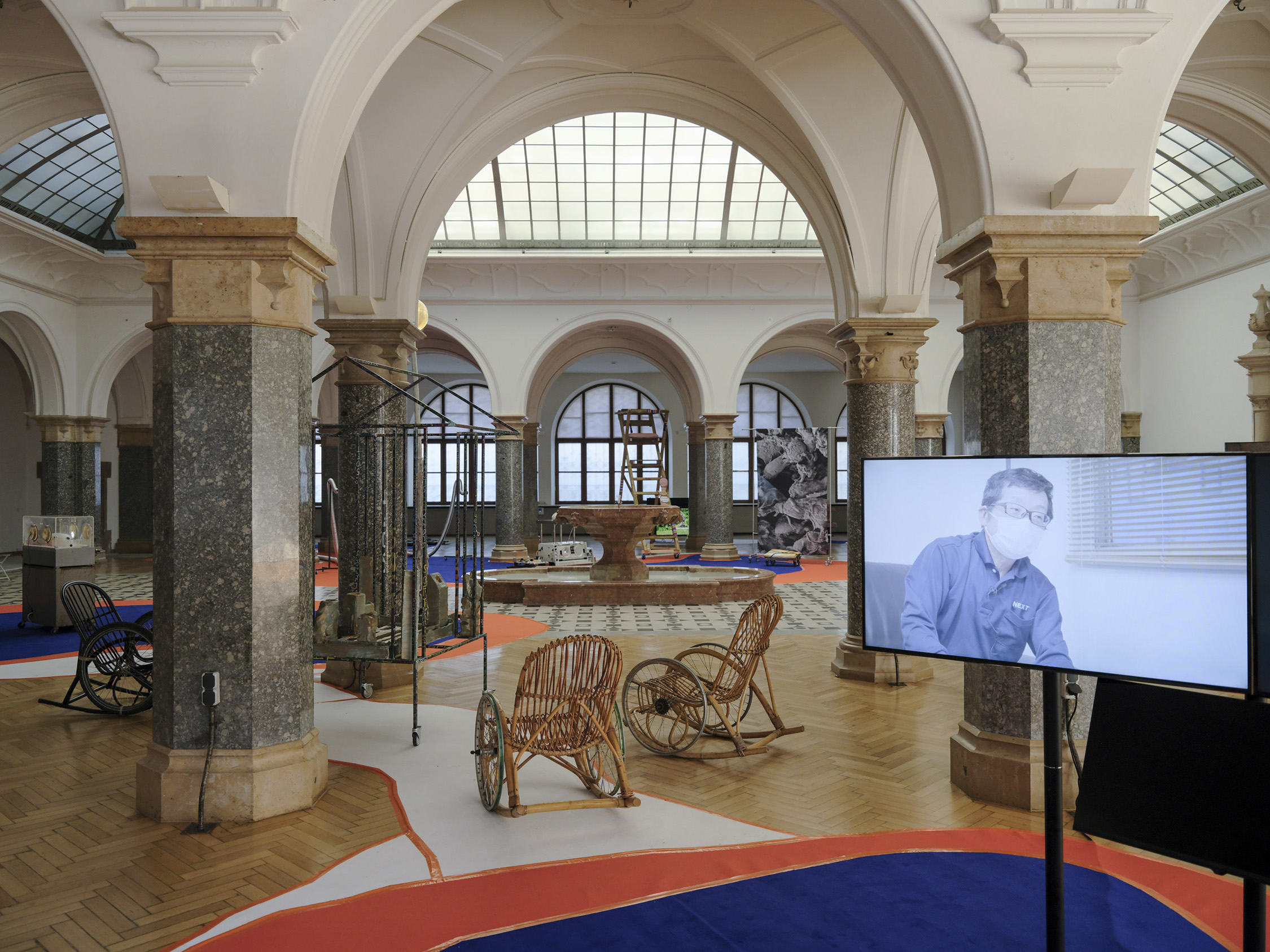
IRENE MACALLI
SPEAK TO ME
Soft aluminum tubing, iron, wheels, spray paint, sound
This concept ties into the theme of the exhibition, addressing emotional connections to distant or imagined places, and the human need to belong to locations one may never have physically visited.
The installation takes the form of a participatory artwork, inspired by the classic children’s game of the “tin can telephone” — traditionally made with string and paper cups. Here, it is reimagined using industrial materials, specifically a flexible aluminum tube.
When interacting with the piece, visitors can listen to the sound of the sea, recorded in southern Italy. These audio clips were collected through an open call on Instagram, with submissions from places like Naples, Apulia, and Calabria, where people shared the ocean sounds of their surroundings.
This marked the beginning of a collaborative and participatory process, with others actively contributing to the creation of the work.
The use of sea sounds creates an emotional connection to the artist’s homeland, evoking feelings of calm and nostalgia. The waves convey a sense of peace while also contrasting with — and connecting to — the urban environment of Munich.
Through this symbolic gesture, a dialogue emerges between two landscapes — southern Italy and the city of Munich. Visitors are invited to speak into the tube or listen to the waves. Only through this shared action does the artwork become complete and activated.
Industrial materials are a recurring element in the artist’s practice, reflecting her ongoing engagement with urban space, architecture, and structural systems. The choice of soft aluminum tubing plays both a functional and symbolic role, linking the industrial to the intimate.

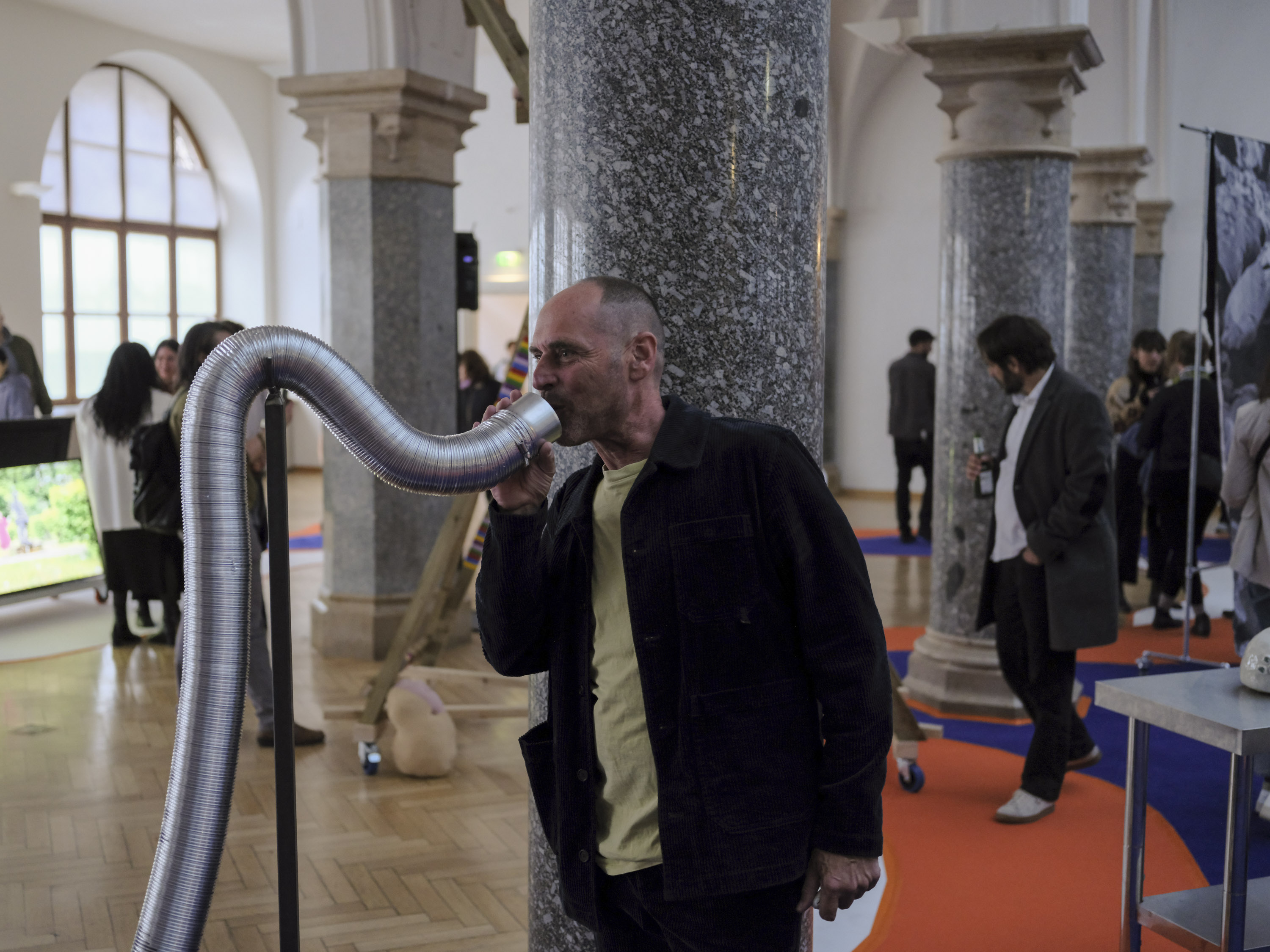
Fotos : Jörg Koopman, Danilo Bastione
